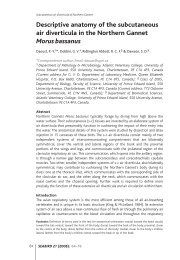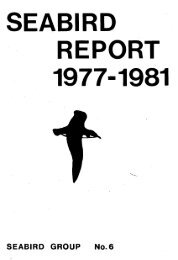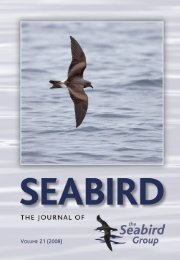You also want an ePaper? Increase the reach of your titles
YUMPU automatically turns print PDFs into web optimized ePapers that Google loves.
2001 European Storm-petrel biology in Brittany 159<br />
As chicks respond more frequently to playback than stated in<br />
Mainwood et al. (1997), especially when about 10 to 20 days old (pers. obs., but<br />
no quantitative data), the proportion of chicks heard during playback census<br />
could be an indicator of the laying phenology. Many responses of chicks would<br />
indicate that the peak of nest attendance by the adults, and thus the better census<br />
period, has been passed beyond. However, more precise data should be<br />
collected on response rate of European Storm-petrel chicks.<br />
In conclusion, data obtained from single visits at the same time in<br />
different years should be interpreted carefully, especially when using tapeplayback<br />
methods only, as the proportion of attended nest sites may be very<br />
different. It appears important to record, as much as possible, an adequate<br />
sample of nest contents and age of chicks when visiting European Storm-petrel<br />
colonies (using plumage features, Davis 1957, or tarsus length, M. Bolton in<br />
Ratcliffe et al. 1998a), in order to investigate the timing of breeding and<br />
discover any delays that could affect the results of the count. Inspecting nests in<br />
a study plot through the season would also be valuable.<br />
European Storm-petrel on Banneg island Stormvogeltje op Banneg-eiland (photo René-Pierre<br />
Bolan)








